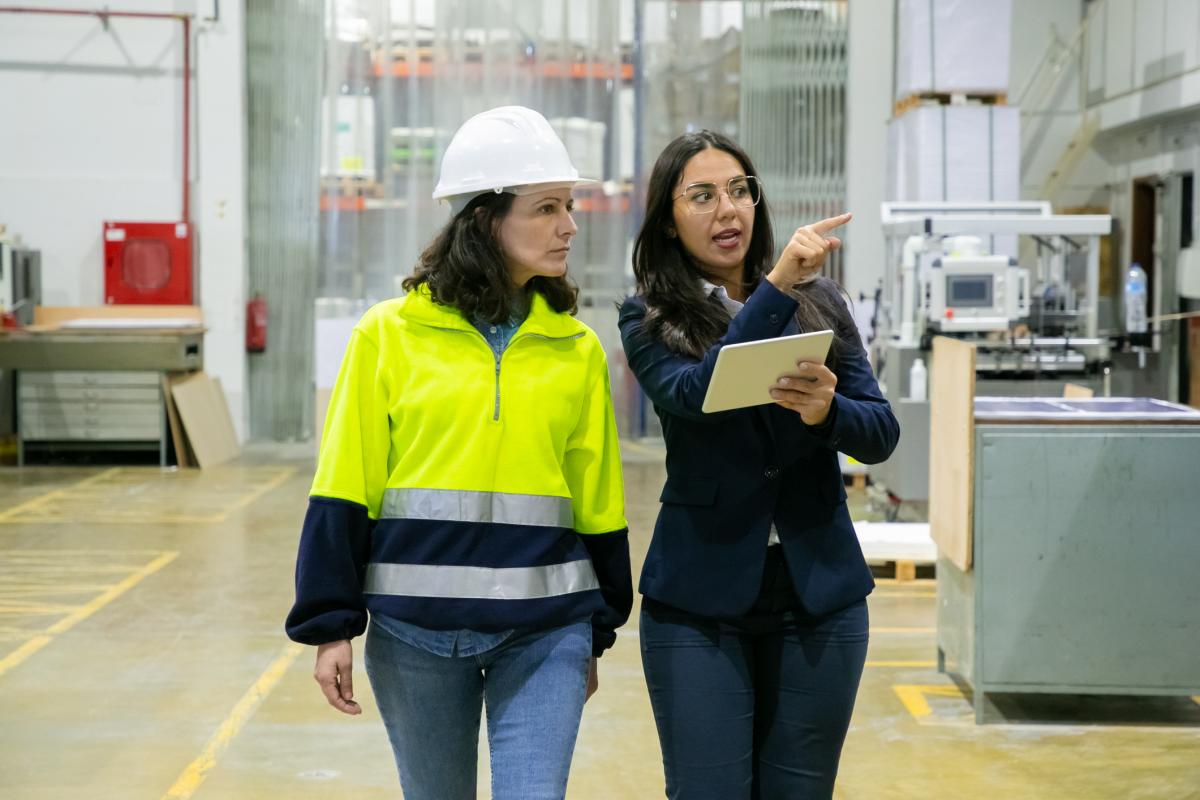Making Safety Hazard Scans Realtime Habits
There are many factors to consider when it comes to evaluating and improving your safety culture. Having the right tools and established processes, particularly around hazard recognition, are important ways to prevent injury and near hit incidents at your company.
Safety scans are something anyone can do anywhere...
Safety Hazard Scans (hereafter called safety scans) are procedures workers can do at the job site to control their personal safety in the face of job hazards present at the beginning of a work task (those hazards that cannot be eliminated entirely by management- “standing hazards”) or job hazards that emerge only once work is underway (“emerging hazards”). Safety scans are something anyone can do anywhere for any kind of task, so they are one of the few universal injury prevention procedures. Safety scans are designed to enhance situation awareness1 (see Endsley, 1995; Killingsworth, Miller, & Alavosius, 2016) and prompt workers to take actions to reduce injury risk during a work task. Safe Work Permits, if “walked down” properly, typically incorporate a safety scan of some kind, but permits are not required for every kind of job, so many companies require safety scans as a routine practice.
 Safety scans add one more layer of protection onto existing hazard controls. Because they are completed in the task environment, workers can look for the actual, specific hazards in the immediate area. For example, workers may know about potential line of fire hazards generally but looking at the task environment at the time of work lets you see the actual line of fire and identify safe zones where workers can stand or walk to avoid the line of fire. Workers judge whether the hazard controls present for this work (engineering controls such as barriers, interlocks, alarms, administrative controls such as their training for the job, safe work procedures, tools and equipment, and, finally, PPE) will keep them safe enough to proceed with the job.
Safety scans add one more layer of protection onto existing hazard controls. Because they are completed in the task environment, workers can look for the actual, specific hazards in the immediate area. For example, workers may know about potential line of fire hazards generally but looking at the task environment at the time of work lets you see the actual line of fire and identify safe zones where workers can stand or walk to avoid the line of fire. Workers judge whether the hazard controls present for this work (engineering controls such as barriers, interlocks, alarms, administrative controls such as their training for the job, safe work procedures, tools and equipment, and, finally, PPE) will keep them safe enough to proceed with the job.
“How could I get hurt doing this task?”
Safety scans go by different names (e.g., field level risk assessment, take two) and different formats, but all share some version of the following steps:
- Pause and ask yourself or discuss with co-workers, “How could I get hurt doing this task?”
- Look for hazards in the task, the nearby physical environment, the equipment to be used, and the people doing the task or those nearby.
- “What do I need to do to keep me safe when completing this task?”
- For example, the worker may have to follow the prescribed safe work procedure, communicate with co-workers at critical steps, deviate from the expected procedure to an alternative safe work procedure, etc.
- If there is no safe way to do the task, the worker should stop work and ask for help from supervision or management. Hazard scans without a stop work policy in place are incomplete; they leave the workers no option but to proceed with the task even if they think it is unsafe to do so.
- Remain alert to emerging hazards once the work task is underway. If such hazards arise, re-scan to decide how best to proceed. This step means that scanning does not end pre-task, so calling the whole procedure a “pre-task scan” is misleading.
Management engagement with safety scans
It is management’s responsibility to provide a safe workplace overall, but because all risk cannot be removed, they must help workers get better at spotting and handling residual hazards on the job. If we view doing safety scans as a sophisticated human skill, it is apparent that safety scanning needs management support to begin and to maintain at high quality over time just like other safety-critical behaviors. Training is needed at first to teach the fundamentals of hazard recognition based on the hazards likely to be encountered for the nature of the work, as well as using the particular scanning procedure itself, including how to use the stop work policy if needed.
 Beyond initial training, to make this tool as effective as possible, additional strengthening should come via coaching interactions from supervision to frontline workers. This kind of post-training coaching is essential to make safety scans a personal habit and a part of the company culture. Here are 4 things supervisors can do to build and maintain high-quality safety scans in the field:
Beyond initial training, to make this tool as effective as possible, additional strengthening should come via coaching interactions from supervision to frontline workers. This kind of post-training coaching is essential to make safety scans a personal habit and a part of the company culture. Here are 4 things supervisors can do to build and maintain high-quality safety scans in the field:
- When onsite with a work crew, lead them through a scan, or observe and coach their scan.
- During or after the task, ask questions about the scan, such as, “What hazards did you spot during your safety scan? What did you decide to do about them to keep you safe?”
- Compliment the good catches and good safety adjustments to reinforce them. Offer constructive feedback for any weak spots you observe directly or hear about in your coaching interaction to prevent the quality from deteriorating.
- Examine the hazards that workers report in this process and decide whether they should be remediated at a management level rather than dealt with ad hoc in safety scans time after time. If workers see that management takes action against chronic or systemic hazards, that will be a powerful reinforcer for doing safety scans and discussing them with their supervisors (Agnew, 2016)2.
The re-scanning step of a safety scan, described earlier, is crucial to preventing harm from emerging hazards as the work proceeds. If the task is of any substantial length, many things can change considerably from what they were pre-task. The weather, lighting conditions, adjacent work crews, and workers’ physical states are just a few very dynamic factors that could pose emerging safety hazards. Re-scanning needs special focus from management because it is often a weaker behavior than pre-task scanning despite the steps being identical. Several factors can inhibit needed re-scanning:
- The focus on the work task itself may give the workers “tunnel vision” and keep them from seeing emerging hazards in the environment.
- As work on the task nears completion, momentum to plow ahead to reach the end may make pausing to scan less likely than earlier in the task. In aviation, this phenomenon is known as “get-there-itis” and has been noted as sometimes contributing to aircraft crashes.
- There is a clear trigger stimulus for a pre-task scan- you’re about to start a new task- but the stimulus for a re-scan is less clear. For example, suppose one of your co-workers seems to be getting fatigued as the task proceeds. When do you call for a re-scan? The threshold for an emerging hazard to be seen as a threat is “when safety conditions change” and that is not a crystal-clear criterion.
The best way to teach that threshold is not through attempts to verbally define it, but through discussion of examples and non-examples with workers to promote community learning. Supervisors might find questions such as, “What changes did you see during the task that might have posed a safety risk, and what did you decide to do about them?” useful to help everyone learn what kinds of situations should trigger re-scans and which should not. It’s best to lean toward re-scanning if in doubt. It is always safer to re-scan when not needed than to fail to re-scan when it was needed.
Managers can have coaching interactions with frontline supervisors to build and maintain their good coaching skills in a “cascaded coaching” process. ADI’s Safety Leadership model is designed to build cascaded coaching and accountability across management levels to strengthen various safety-critical behaviors such as doing effective safety scans. Companies trying to improve their safety culture would benefit from adding safety scans to their safe work procedures and engaging management to make them meaningful tools in use.
ADI’s Safety Leadership approach supports organizations in developing positive, proactive safety management skills that build engagement and strengthen safety culture. Contact ADI to learn how we can help you and your organization.
1Endsley, M.R. (1995). Toward a theory of situation awareness in dynamic situations. Human Factors, 37, 65-84. DOI:10.1518/001872095779049543.
Killingsworth, K., Miller, S.A., & Alavosius, M.P. (2016). A behavioral interpretation of situation awareness: Prospects for Organizational Behavior Management, Journal of Organizational Behavior Management, 36:4, 301-321. DOI:10.1080/01608061.2016.1236056.
2Agnew, J., (2016). A Supervisor’s Guide to (Safety) Leadership. Performance Management Publications.


